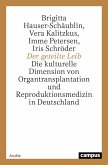
Alle Infos zum eBook verschenken


Alle Infos zum eBook verschenken

- Format: PDF
- Merkliste
- Auf die Merkliste
- Bewerten Bewerten
- Teilen
- Produkt teilen
- Produkterinnerung
- Produkterinnerung

Hier können Sie sich einloggen

Bitte loggen Sie sich zunächst in Ihr Kundenkonto ein oder registrieren Sie sich bei bücher.de, um das eBook-Abo tolino select nutzen zu können.
Openness about sperm and egg donation and the regulation of donor anonymity or non-anonymity are new phenomena. How do affected families, clinics, and regulators deal with information about gamete donors and the donation itself? And how does this knowledge management contribute to the creation and enactment of kinship? Addressing these questions in Germany and Britain, this ethnography makes a comparative contribution to the empirical and theoretical analysis of kin-formation and social change. Maren Klotz reveals a contemporary renegotiation of the values of privacy, information-sharing, and…mehr
- Geräte: PC
- ohne Kopierschutz
- eBook Hilfe
- Größe: 3.86MB
- FamilySharing(5)
![Reproductive Technologies as Global Form (eBook, PDF) Reproductive Technologies as Global Form (eBook, PDF)]() Reproductive Technologies as Global Form (eBook, PDF)41,99 €
Reproductive Technologies as Global Form (eBook, PDF)41,99 €![Der geteilte Leib (eBook, PDF) Der geteilte Leib (eBook, PDF)]() Brigitta Hauser-SchäublinDer geteilte Leib (eBook, PDF)83,99 €
Brigitta Hauser-SchäublinDer geteilte Leib (eBook, PDF)83,99 €![Peripheral Labour Mobilities (eBook, PDF) Peripheral Labour Mobilities (eBook, PDF)]() Tanja VisicPeripheral Labour Mobilities (eBook, PDF)40,99 €
Tanja VisicPeripheral Labour Mobilities (eBook, PDF)40,99 €![Food for Thought (eBook, PDF) Food for Thought (eBook, PDF)]() Julia BernsteinFood for Thought (eBook, PDF)41,99 €
Julia BernsteinFood for Thought (eBook, PDF)41,99 €![Zauberpraktiken als Lebenshilfe (eBook, PDF) Zauberpraktiken als Lebenshilfe (eBook, PDF)]() Margarethe RuffZauberpraktiken als Lebenshilfe (eBook, PDF)41,99 €
Margarethe RuffZauberpraktiken als Lebenshilfe (eBook, PDF)41,99 €![Vom Ritual zum Theater (eBook, PDF) Vom Ritual zum Theater (eBook, PDF)]() Victor TurnerVom Ritual zum Theater (eBook, PDF)26,99 €
Victor TurnerVom Ritual zum Theater (eBook, PDF)26,99 €![Urbane Psyche (eBook, PDF) Urbane Psyche (eBook, PDF)]() Patrick BielerUrbane Psyche (eBook, PDF)0,00 €
Patrick BielerUrbane Psyche (eBook, PDF)0,00 €-
-
-
Dieser Download kann aus rechtlichen Gründen nur mit Rechnungsadresse in A, B, BG, CY, CZ, D, DK, EW, E, FIN, F, GR, HR, H, IRL, I, LT, L, LR, M, NL, PL, P, R, S, SLO, SK ausgeliefert werden.
- Produktdetails
- Verlag: Campus Verlag GmbH
- Seitenzahl: 383
- Erscheinungstermin: 15. Mai 2014
- Englisch
- ISBN-13: 9783593422718
- Artikelnr.: 40874856
- Verlag: Campus Verlag GmbH
- Seitenzahl: 383
- Erscheinungstermin: 15. Mai 2014
- Englisch
- ISBN-13: 9783593422718
- Artikelnr.: 40874856
- Herstellerkennzeichnung Die Herstellerinformationen sind derzeit nicht verfügbar.
Acknowledgements...........................................................................11
1. Introduction .................................................................................13
2. Three Conceptual Arrival Scenes: Comparative Vantage Point, Kinship and Knowledge, Kinship Matters............................................................................29
Scene 1: Knowledge-Management During Gamete Donation as Policy Problem in Britain and Germany ........................31
Scene 2: Kinship and Knowledge in Anthropology .........................41
Scene 3: What's the Matter with Kinship? ......................................55
3. Fieldwork and Data Analysis.......................................................65
4. Knowing Kinship-by-Donation as Parents: Reflections and Histories.............................................................79
4.1 What is Kinship? Characteristic Tensions of Choice, (Corporeal) Continuity, and Love ............................................81
4.2 Reproductive Histories and DI as a Technology of the Last Resort .....................................................................90
5. Clinical Knowledge-Management and Beyond: How Kinship-by-Donation Becomes Constituted in Clinics.....................................................................................103
5.1 Local Fieldwork-Local Regulations ......................................106
5.2 The Medical Trajectory of Knowing Kinship-by-Donation: The WHO standard, Viruses, and Excel Sheets................................................................................117
5.3 The Accessible Clinical/Institutional Trajectory of Knowing Kinship-by-Donation: Sealed Envelopes, Donor Files, and a National Registry......................................169
6. Familial Knowledge-Management: Emerging Canons and Parental Reflections.............................185
6.1 Normative Canons of Knowledge-Management .....................186
6.2 Familial Moralities of Knowledge-Management......................219
7. Familial Knowledge-Management: Everyday Practices and Emerging Relations ............................229
7.1 Getting to Know the Donor: The Constitution of Administered Relations ..........................................................231
7.2 Of Donors and Daddies, Fathers, (Co-)Mothers, Moms, and Mommies: Naming and Terminology Work .....................................................................................247
7.3 Telling the Child ....................................................................257
7.4 Subversive Knowledge-Management and Wayward Relations ................................................................................266
8. Familial Knowledge-Management: Confrontations and Tactics .......................................................293
8.1 Resemblance-Talk: "The old folks would always say 'Just like Daddy', no matter how the child looks like" ..............................................................................295
8.2 Medical History: "Not that we're aware of " ...........................311
8.3 Kinship Terminology: "Will they meet their real father?" .......317
8.4 Not Conforming to the Reproductive Norm: "Is it true that Jonas has two moms?"...........................................318
8.5 Biological Reproduction as a Confirmation of Heterosexual Love and Virility: "Well done, nice shot!"................322
8.6 The Child Talks: "If we have eggs in the kitchen, we also need sperm for Daddy" ..............................................326
9. Conclusions ................................................................................331
9.1 National and Transnational Regulation and the Constitution of Kinship-by-Donation........................333
9.2 Transparentization ..................................................................337
9.3 Diverse Fields of Authoritative Kno
Content
Acknowledgements...........................................................................11
1. Introduction .................................................................................13
2. Three Conceptual Arrival Scenes: Comparative Vantage Point, Kinship and Knowledge, Kinship Matters............................................................................29
Scene 1: Knowledge-Management During Gamete Donation as Policy Problem in Britain and Germany ........................31
Scene 2: Kinship and Knowledge in Anthropology .........................41
Scene 3: What's the Matter with Kinship? ......................................55
3. Fieldwork and Data Analysis.......................................................65
4. Knowing Kinship-by-Donation as Parents: Reflections and Histories.............................................................79
4.1 What is Kinship? Characteristic Tensions of Choice, (Corporeal) Continuity, and Love ............................................81
4.2 Reproductive Histories and DI as a Technology of the Last Resort .....................................................................90
5. Clinical Knowledge-Management and Beyond: How Kinship-by-Donation Becomes Constituted in Clinics.....................................................................................103
5.1 Local Fieldwork-Local Regulations ......................................106
5.2 The Medical Trajectory of Knowing Kinship-by-Donation: The WHO standard, Viruses, and Excel Sheets................................................................................117
5.3 The Accessible Clinical/Institutional Trajectory of Knowing Kinship-by-Donation: Sealed Envelopes, Donor Files, and a National Registry......................................169
6. Familial Knowledge-Management: Emerging Canons and Parental Reflections.............................185
6.1 Normative Canons of Knowledge-Management .....................186
6.2 Familial Moralities of Knowledge-Management......................219
7. Familial Knowledge-Management: Everyday Practices and Emerging Relations ............................229
7.1 Getting to Know the Donor: The Constitution of Administered Relations ..........................................................231
7.2 Of Donors and Daddies, Fathers, (Co-)Mothers, Moms, and Mommies: Naming and Terminology Work .....................................................................................247
7.3 Telling the Child ....................................................................257
7.4 Subversive Knowledge-Management and Wayward Relations ................................................................................266
8. Familial Knowledge-Management: Confrontations and Tactics .......................................................293
8.1 Resemblance-Talk: "The old folks would always say 'Just like Daddy', no matter how the child looks like" ..............................................................................295
8.2 Medical History: "Not that we're aware of " ...........................311
8.3 Kinship Terminology: "Will they meet their real father?" .......317
8.4 Not Conforming to the Reproductive Norm: "Is it true that Jonas has two moms?"...........................................318
8.5 Biological Reproduction as a Confirmation of Heterosexual Love and Virility: "Well done, nice shot!"................322
8.6 The Child Talks: "If we have eggs in the kitchen, we also need sperm for Daddy" ..............................................326
9. Conclusions ................................................................................331
9.1 National and Transnational Regulation and the Constitution of Kinship-by-Donation........................333
9.2 Transparentization ..................................................................337
9.3 Diverse Fields of Authoritative Kno
Acknowledgements...........................................................................11
1. Introduction .................................................................................13
2. Three Conceptual Arrival Scenes: Comparative Vantage Point, Kinship and Knowledge, Kinship Matters............................................................................29
Scene 1: Knowledge-Management During Gamete Donation as Policy Problem in Britain and Germany ........................31
Scene 2: Kinship and Knowledge in Anthropology .........................41
Scene 3: What's the Matter with Kinship? ......................................55
3. Fieldwork and Data Analysis.......................................................65
4. Knowing Kinship-by-Donation as Parents: Reflections and Histories.............................................................79
4.1 What is Kinship? Characteristic Tensions of Choice, (Corporeal) Continuity, and Love ............................................81
4.2 Reproductive Histories and DI as a Technology of the Last Resort .....................................................................90
5. Clinical Knowledge-Management and Beyond: How Kinship-by-Donation Becomes Constituted in Clinics.....................................................................................103
5.1 Local Fieldwork-Local Regulations ......................................106
5.2 The Medical Trajectory of Knowing Kinship-by-Donation: The WHO standard, Viruses, and Excel Sheets................................................................................117
5.3 The Accessible Clinical/Institutional Trajectory of Knowing Kinship-by-Donation: Sealed Envelopes, Donor Files, and a National Registry......................................169
6. Familial Knowledge-Management: Emerging Canons and Parental Reflections.............................185
6.1 Normative Canons of Knowledge-Management .....................186
6.2 Familial Moralities of Knowledge-Management......................219
7. Familial Knowledge-Management: Everyday Practices and Emerging Relations ............................229
7.1 Getting to Know the Donor: The Constitution of Administered Relations ..........................................................231
7.2 Of Donors and Daddies, Fathers, (Co-)Mothers, Moms, and Mommies: Naming and Terminology Work .....................................................................................247
7.3 Telling the Child ....................................................................257
7.4 Subversive Knowledge-Management and Wayward Relations ................................................................................266
8. Familial Knowledge-Management: Confrontations and Tactics .......................................................293
8.1 Resemblance-Talk: "The old folks would always say 'Just like Daddy', no matter how the child looks like" ..............................................................................295
8.2 Medical History: "Not that we're aware of " ...........................311
8.3 Kinship Terminology: "Will they meet their real father?" .......317
8.4 Not Conforming to the Reproductive Norm: "Is it true that Jonas has two moms?"...........................................318
8.5 Biological Reproduction as a Confirmation of Heterosexual Love and Virility: "Well done, nice shot!"................322
8.6 The Child Talks: "If we have eggs in the kitchen, we also need sperm for Daddy" ..............................................326
9. Conclusions ................................................................................331
9.1 National and Transnational Regulation and the Constitution of Kinship-by-Donation........................333
9.2 Transparentization ..................................................................337
9.3 Diverse Fields of Authoritative Kno
Content
Acknowledgements...........................................................................11
1. Introduction .................................................................................13
2. Three Conceptual Arrival Scenes: Comparative Vantage Point, Kinship and Knowledge, Kinship Matters............................................................................29
Scene 1: Knowledge-Management During Gamete Donation as Policy Problem in Britain and Germany ........................31
Scene 2: Kinship and Knowledge in Anthropology .........................41
Scene 3: What's the Matter with Kinship? ......................................55
3. Fieldwork and Data Analysis.......................................................65
4. Knowing Kinship-by-Donation as Parents: Reflections and Histories.............................................................79
4.1 What is Kinship? Characteristic Tensions of Choice, (Corporeal) Continuity, and Love ............................................81
4.2 Reproductive Histories and DI as a Technology of the Last Resort .....................................................................90
5. Clinical Knowledge-Management and Beyond: How Kinship-by-Donation Becomes Constituted in Clinics.....................................................................................103
5.1 Local Fieldwork-Local Regulations ......................................106
5.2 The Medical Trajectory of Knowing Kinship-by-Donation: The WHO standard, Viruses, and Excel Sheets................................................................................117
5.3 The Accessible Clinical/Institutional Trajectory of Knowing Kinship-by-Donation: Sealed Envelopes, Donor Files, and a National Registry......................................169
6. Familial Knowledge-Management: Emerging Canons and Parental Reflections.............................185
6.1 Normative Canons of Knowledge-Management .....................186
6.2 Familial Moralities of Knowledge-Management......................219
7. Familial Knowledge-Management: Everyday Practices and Emerging Relations ............................229
7.1 Getting to Know the Donor: The Constitution of Administered Relations ..........................................................231
7.2 Of Donors and Daddies, Fathers, (Co-)Mothers, Moms, and Mommies: Naming and Terminology Work .....................................................................................247
7.3 Telling the Child ....................................................................257
7.4 Subversive Knowledge-Management and Wayward Relations ................................................................................266
8. Familial Knowledge-Management: Confrontations and Tactics .......................................................293
8.1 Resemblance-Talk: "The old folks would always say 'Just like Daddy', no matter how the child looks like" ..............................................................................295
8.2 Medical History: "Not that we're aware of " ...........................311
8.3 Kinship Terminology: "Will they meet their real father?" .......317
8.4 Not Conforming to the Reproductive Norm: "Is it true that Jonas has two moms?"...........................................318
8.5 Biological Reproduction as a Confirmation of Heterosexual Love and Virility: "Well done, nice shot!"................322
8.6 The Child Talks: "If we have eggs in the kitchen, we also need sperm for Daddy" ..............................................326
9. Conclusions ................................................................................331
9.1 National and Transnational Regulation and the Constitution of Kinship-by-Donation........................333
9.2 Transparentization ..................................................................337
9.3 Diverse Fields of Authoritative Kno







